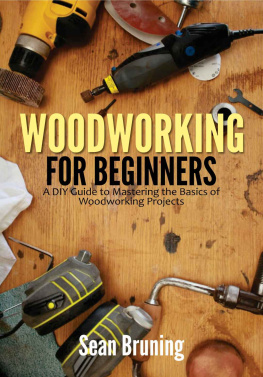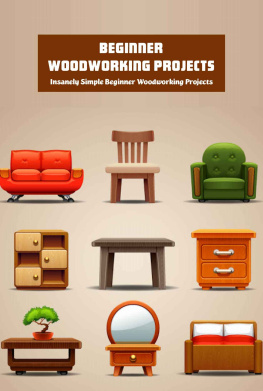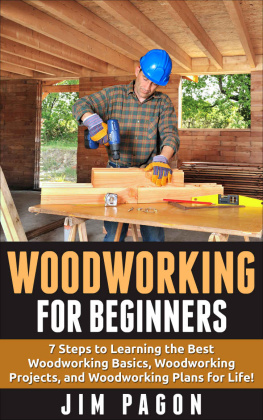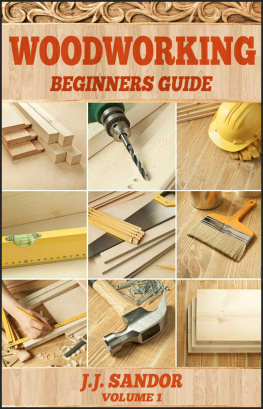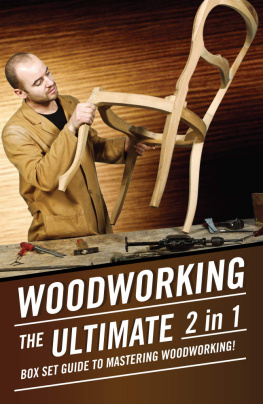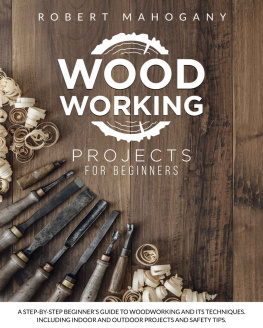Sean Bruning - Woodworking for Beginners: A DIY Guide to Mastering the Basics of Woodworking Projects
Here you can read online Sean Bruning - Woodworking for Beginners: A DIY Guide to Mastering the Basics of Woodworking Projects full text of the book (entire story) in english for free. Download pdf and epub, get meaning, cover and reviews about this ebook. year: 2020, genre: Children. Description of the work, (preface) as well as reviews are available. Best literature library LitArk.com created for fans of good reading and offers a wide selection of genres:
Romance novel
Science fiction
Adventure
Detective
Science
History
Home and family
Prose
Art
Politics
Computer
Non-fiction
Religion
Business
Children
Humor
Choose a favorite category and find really read worthwhile books. Enjoy immersion in the world of imagination, feel the emotions of the characters or learn something new for yourself, make an fascinating discovery.
- Book:Woodworking for Beginners: A DIY Guide to Mastering the Basics of Woodworking Projects
- Author:
- Genre:
- Year:2020
- Rating:4 / 5
- Favourites:Add to favourites
- Your mark:
- 80
- 1
- 2
- 3
- 4
- 5
Woodworking for Beginners: A DIY Guide to Mastering the Basics of Woodworking Projects: summary, description and annotation
We offer to read an annotation, description, summary or preface (depends on what the author of the book "Woodworking for Beginners: A DIY Guide to Mastering the Basics of Woodworking Projects" wrote himself). If you haven't found the necessary information about the book — write in the comments, we will try to find it.
Sean Bruning: author's other books
Who wrote Woodworking for Beginners: A DIY Guide to Mastering the Basics of Woodworking Projects? Find out the surname, the name of the author of the book and a list of all author's works by series.
Woodworking for Beginners: A DIY Guide to Mastering the Basics of Woodworking Projects — read online for free the complete book (whole text) full work
Below is the text of the book, divided by pages. System saving the place of the last page read, allows you to conveniently read the book "Woodworking for Beginners: A DIY Guide to Mastering the Basics of Woodworking Projects" online for free, without having to search again every time where you left off. Put a bookmark, and you can go to the page where you finished reading at any time.
Font size:
Interval:
Bookmark:
Woodworking for Beginners
A DIY Guide to Mastering the Basics of Woodworking Projects
Sean
Bruning
Copyright 2020 Sean Bruning
All rights reserved.
It is not legal to reproduce, duplicate, or transmit any part of this document by either electronic means or in printed format. Recording of this publication is strictly prohibited
Disclaimer
The information in this book is based on personal experience and anecdotal evidence. Although the author has made every attempt to achieve an accuracy of the information gathered in this book, they make no representation or warranties concerning the accuracy or completeness of the contents of this book. Your circumstances may not be suited to some illustrations in this book.
The author disclaims any liability arising directly or indirectly from the use of this book. Readers are encouraged to seek Medical. Accounting, legal, or professional help when required.
This guide is for informational purposes only, and the author does not accept any responsibilities for any liabilities resulting from the use of this information. While every attempt has been made to verify the information provided here, the author cannot assume any responsibility for errors, inaccuracies or omission.
Contents
Woodworking is an exciting craftsmanship that requires high-level knowledge and technical skills. You may not be able to craft and design your favorite furniture without the necessary tools.
Experienced woodworkers began the journey using bits and pieces of wood until they gained enough experience on how to shape, sand, and finish a piece of furniture from lumber. Moreover, you need to learn how to get the right measurement for whatever product you want to construct.
This book presents woodworking in the simplest form and the most straightforward language that a beginner can grasp quickly. You will understand the types of wood, such as softwoods and hardwoods, useful for furniture and other accessories.
Most importantly, I have carefully mentioned some indoor furniture and accessories, including outdoor furniture and accessories that a beginner can embark on after reading it. Study them carefully and follow the steps to build fantastic wooden pieces for your home and outdoor places.
Are you skillful and patient in learning and practicing the art of woodworking? Most individuals do it as a career, while others go into woodworking as a hobby. They engage in the production of various wooden accessories for their homes and even commercial purposes.
But you need to set up a workshop for your woodwork activities. This will enhance your efficiency in the business. Learn how to set up your workshop following these procedures:
- Get a large room for installing various instruments in your wood workshop this consideration is necessary due to the multiple tools you need to mount in the shop. Here are some of the tools:
- Miter saws for cutting lumber.
- Scroll saws for cutting small pieces of wood.
- Band saws same as scroll saws.
- Shapers, planers, and routers are installed on a table for constructing a piece of furniture.
- Table saws for cutting wood.
- A workbench for installing benchtop equipment.
Another reason for securing a large space is to have large storage space for your tools and other accessories.
- Fix enough lightning and other electrical outlets in the workshop to prevent accidents. Minimize unnecessary extension cords in your workshop due to the risk of electric shock.
- Maintain proper ventilation in your workshop to prevent choking sensation when using adhesives, paints, and stains. Also, woodwork produces too much dust that can lead to breathing difficulty if there is no proper ventilation.
- Create a wider door for your workshop if you construct large furniture that will be moved out of your shop. You can have a double door or a roll-up door for your shop.
- You can have a ceiling with ten-foot height.
- Sketch your floor plan with the footprint of each machine. Then, enumerate all the tools and appliances you need to mount in your workshop. Create enough space to move around in the shop while handling materials and other accessories.
- Consider hanging hand tools and other items behind workbenches and pegboard panels. This will make it accessing them very easy.
- If your space cannot contain full-size stationary equipment, get portable instruments to put in your workshop. Another way is by purchasing multi-purpose machines for your projects.
- Make your wood workshop a luxurious space by remodeling it as much as possible from time to time.
- Create unique storage places for smaller tools, fasteners, and other remote parts of equipment to ensure they are not misplaced.

Dust Collection Sack
A typical woodworking shop needs a place for storing lumber, tools, and stationary machines, including an area for finishing the construction. However, due to the volume of debris and dust produced during woodworks, it is expedient to create a dust collection process.
Nowadays, dust collection is necessary in a workshop to maintain a safe and healthy place for both workers and visitors alike. Even if you are using hand tools, you still need to plan for a dust collection method. But if you have power tools capable of producing enormous airborne dust, you have to prepare for a dust collection process to prevent exposing your lungs and health in general to infections.
Here are some methods of dust collection in a wood workshop:
- Collecting the dust right from the machine or source generating the dust.
- Using a modern dust collection system this comprises of a central dust collector with tubing, pipes, or ducts. This is necessary if you have heavy-duty producers of dust such as sanding machines, jointer, table saw, bandsaw, router table, and thickness planer. You can use 1 horsepower or 2 horsepower dust collectors for this process.
- Another method is using a 1.5 horsepower single stage dust collector equipment. This is connected to a cyclone lid set up with blast gates that regulate the input. You can see this feature close to the dust port of every machine.
- Dust collection using a bandsaw You can use a bandsaw to collect the fine dust created by the wheel's motion and blade.
Examples of dust collectors include:
- Shop Fox W1685 Dust collector.
- The Dust Deputy Deluxe by Oneida Air Systems.
- Jet JCDC-1. Cyclone Dust Collector.
- Grizzly G8027 Dust collector.
- Powermatic Dust Collector PM1300TX-CK.
- SHOP FOX W1727 Dust collector.
- Shop Fox Wall Dust Collector W1826.
- Jet DC-1100VX-5M Dust collector.
- POWERTEC Wall Mounted Dust collector DC5370.
- Baileigh Cyclone Style DC-1450C Dust collector.
Working in a wood workshop could be exciting and dangerous simultaneously, especially for newbies in the industry. Various safety equipment is needed for protection to ensure smooth working processes.
Here are some of the essential tools you need in your workshop to maintain and enhance safety:
- Put on Face masks to protect you from inhaling sawdust and debris from woodworking materials.
- Safety glasses for the eyes varieties of safety glasses are designed with impact-resistant lenses and side screens. They will protect your eyes from electric sparks, debris, and dust.
Font size:
Interval:
Bookmark:
Similar books «Woodworking for Beginners: A DIY Guide to Mastering the Basics of Woodworking Projects»
Look at similar books to Woodworking for Beginners: A DIY Guide to Mastering the Basics of Woodworking Projects. We have selected literature similar in name and meaning in the hope of providing readers with more options to find new, interesting, not yet read works.
Discussion, reviews of the book Woodworking for Beginners: A DIY Guide to Mastering the Basics of Woodworking Projects and just readers' own opinions. Leave your comments, write what you think about the work, its meaning or the main characters. Specify what exactly you liked and what you didn't like, and why you think so.

